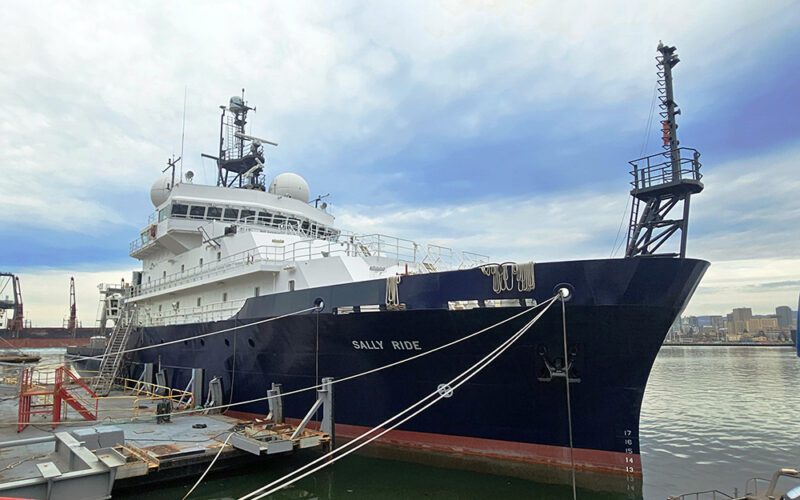Yard infrastructure projects, facility upgrades and work on notable vessels have kept West Coast shipyards busy over the past year as they take on major jobs and expand operations.
Some have purchased new cranes and expanded drydocks, others completed maintenance and repowers on historic boats and a few handled unique projects.
Pacific Maritime reached out to yards to find out the latest news, notable jobs and yard improvement projects.
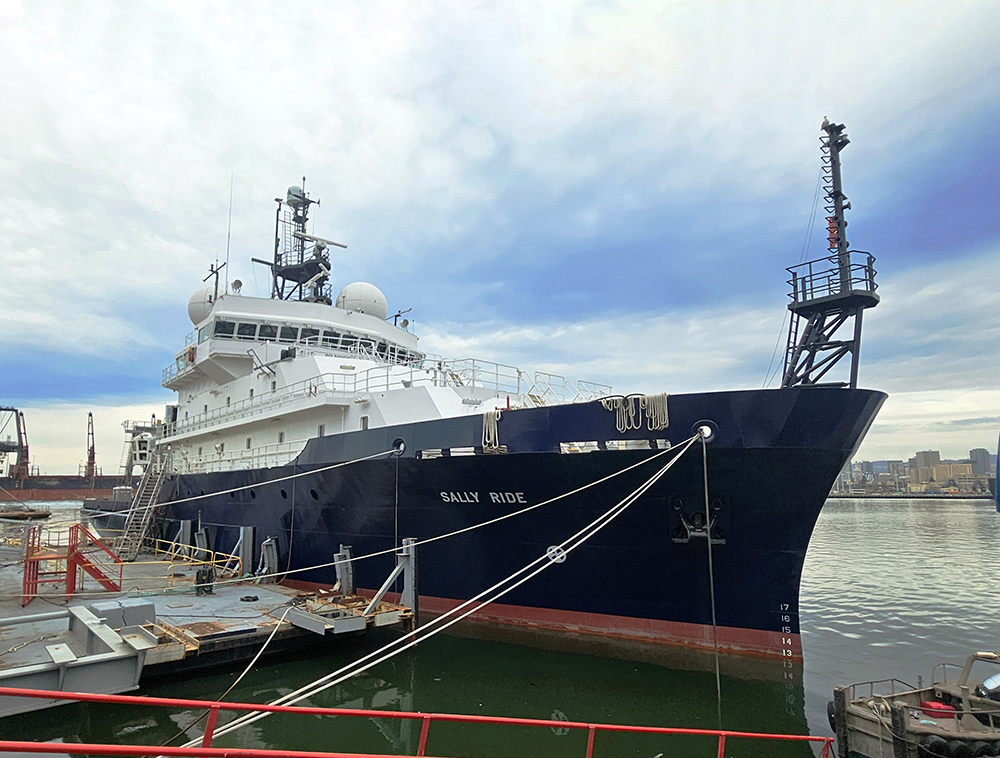
Bay Ship and Yacht Co.
The big news out of Alameda, Calif.-based Bay Ship and Yacht Co. is the change to employee ownership though an Employee Stock Ownership Plan (ESOP), Bay Ship and Yacht CEO Joel Welter wrote in an email to Pacific Maritime.
“This transition was initiated by BSY’s owners after they explored many options and concluded that selling to BSY’s employees is the best way to ensure that the organization continues to thrive,” he explained.
The yard has been busy over the last 12 months, he added, as BSY has docked 91 vessels, performed six repowers, completed more than 50 blast jobs and launched one new build-float, which promptly went to work right next door at Alameda’s Main Street Ferry Landing.
BSY has also recently had a couple of notable vessels at the yard, including the National Park Service’s historic vessel, Hercules, and the Scripps Institute of Oceanology research vessel, Sally Ride.
Welter said Hercules is undergoing a major structural renewal. The project involves the installation of thousands of new rivets to replace framing and plating, something BSY has not done since the Hercules’ neighbor at the San Francisco Maritime Museum, the Eppleton Hall, was in for repairs in 2013.
Sally Ride is the fourth research vessel at BSY in the past year.
“We think that BSY’s advanced project management ability and commitment to meet our customers’ timelines is one of the reasons that we have seen an uptick in research vessel work in the past few years,” Welter noted.
The yard is also home to a new Grove 165-ton, all-terrain crane after being awarded a small shipyard grant from the U.S. Department of Transportation’s Maritime Administration (MARAD). The grant program is designed to support small shipyards that make capital and related improvements.
“This addition to the yard has eliminated the need to rent cranes for most heavy lifts and has added to the yard’s lifting resources, alleviating a bottleneck,” Welter commented.
Other recent improvements include moving all technical and project managers from mobile job trailers into a new purpose-built space. The new offices allow the 25-person crew to better communicate, coordinate and lead shipyard activities, Welter said.
The land the trailers previously occupied is expected to be repurposed as new workstations for additional vessel repair or newbuilds at the yard.
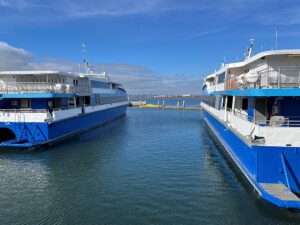
Marine Group Boat Works
Marine Group Boat Works, a family-owned, full-service boat construction and superyacht re-fit facility near San Diego, also has some big projects underway.
The shipyard is investing millions in state-of-the art equipment as part of a large-scale modernization project, officials announced last October. The aim is to support environmental sustainability goals and enhance capacity to serve the superyacht industry.
Plans call for a new mobile boat lift, which would be the only sideways-crawling travelift on the West Coast and the largest in the U.S, according to MGBW.
Italian company Cimolai Technology has been tapped to custom build the 820-ton mobile telescopic boat hoist, which will be able to haul a superyacht out of the water and transport it forward, backward and sideways on wheels that are able to turn 90 degrees.
The giant lift also would be able to adjust its width, expanding up to 18.5 feet or collapsing for vessels with smaller beams. It includes a tier 4 low-emissions power source.
The build-out is expected to take 12 months, with delivery set for this fall.
Last year, MGBW also purchased a 75-ton marine travelift to increase capacity at its yacht repair and dry-dock facility in Los Cabos, Baja California, Mexico.
The modernization project also includes the largest solar panel installation on the San Diego waterfront, MGBW officials noted. The panels would provide 500 kilowatts of renewable energy to power yard equipment and supply shore-power to docked boats.
The project also includes the replacement and reconfiguration of all docks and dredging to restore deep-water access.
The modernization project begins this spring and is slated to be completed by 2027.
In addition to the construction plans, MGBW is also redesigning its entrance aesthetics, MGBW spokesperson Leah Yam told Pacific Maritime. This includes installing new fencing and renovating the parking lot to offer increased parking to both customers and employees.
In terms of recent notable projects, Marine Group Boat Works continued its work on the San Francisco Bay ferries. The company was recently awarded several contracts that resulted in four Golden Gate vessels coming to San Diego for shipyard work in the last year, Yam said.
The m/v Golden Gate and m/v Napa underwent similar repairs valued at more than $3 million. The company also worked on m/v Del Norte and m/v Mendocino. At press time, three of the four vessels had been re-delivered and work was wrapping up on the Napa.
MGBW also won a competitive bid for the m/v Dorado¸ one of the newer additions to the San Francisco Water Emergency Transportation Authority’s fleet.
Under the nearly $500,000 contract, the company is responsible for performing routine inspections, coatings system repairs, jet drive work and USCG maintenance items, Yam explained. Work was expected to take about four weeks.
A research vessel from the University of California, San Diego’s Scripps Institution of Oceanography, also recently returned to the MGBW yard for a five-year ABS inspection to renew its load-line certificate. MGBW has been servicing r/v Gordon Sproul since 2012 and after recently inspecting the structural integrity of the vessel, it was found to need extensive replacing, Yam explained.
“The metal work discovered was unplanned and very substantial,” she noted.
Another notable contract is with the Los Angeles Fire Department. MGBW is tasked with repairing and maintaining two of the LAFD’s largest fireboats in the multi-year agreement. Work includes painting, servicing shafts and props and structural reinforcements for the modern 105-foot Fireboat #2 and the historic 76-foot Fireboat #4.
“The contract, worth upward of one million dollars, was awarded based off MGBW’s unique qualifications and capacity to perform the work,” Yam said.
Seaspan
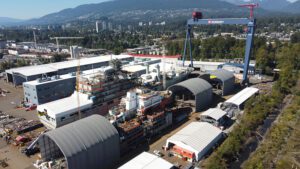
Infrastructure investment is also happening at Seaspan’s Vancouver Drydock in British Columbia, as officials announced plans to expand and upgrade the facility to help grow the company’s ship repair and maintenance operations to better serve the Pacific Northwest, said Seaspan Director of Communications Ali Hounsell in an email to Pacific Maritime.
Plans include two new floating drydocks, a new operations building and a complete upgrade and extension to the current careen deck to enhance its capabilities. The project will extend Seaspan’s current water lot by 40 meters and add two new smaller drydocks and a floating work pontoon to the west of two existing drydocks.
“By investing in improvements to better use our land and the space within our water lots, we will be able to serve more customers, create new jobs and harness new economic activity for our communities,” Vancouver Drydock Vice President and General Manager Paul Hebson said in a statement.
The shipyard has been running at or near capacity for several years after ship repair and maintenance projects were consolidated at the facility. The drydock expansion would increase Seaspan’s capacity for ship repair projects by about 30%, officials said.
Vancouver Drydock successfully completed 37 ship repair and maintenance projects in 2023 on a wide variety of vessels.
“With an exceptionally high dock occupancy (including both wet and dry dockings), 2023 was a very successful year for the team,” Hounsell noted.
The project’s expected to take about a year to complete.
One of the vessels utilizing the Vancouver drydock last April was the FRPD-309, a dredger capable of using suction to remove and transport sediment and sand from the seabed.
“The team focused on steel repairs, replacing and repairing the bottom hatches, replacing several hopper bulkheads in the tanks, as well as some minor mechanical work on the hub and the propellers,” she explained.
Currently at Seaspan’s Vancouver Drydock, work is underway on an extensive refit project on the CCGS Sir Wilfrid Laurier.
The vessel arrived at the facility in November. The six-month long refit project consists of a number of different jobs, including replacement of three 42-ton engines as well as repair, blast and paint work on the interior and exterior of the vessel. Work also includes installation of a new shipboard integrated communication system using more than 15km of new cable, fabrication and installation of new towing bollard on the aft deck and repair and refit of the rudder and shafting.
This is one of the biggest projects the Vancouver Drydock team has taken on in recent years, Seaspan said in an announcement.
Over at Seaspan’s Victoria, B.C. shipyards, one long-term project wrapped up while a number of commercial vessels also came and went, Hounsell said.
Last May, HMCS Regina was officially delivered back to the Royal Canadian Navy. The action marked “the first full docking work period to be completed under the shipyard’s Halifax-Class Work Period contract to maintain and modernize Canada’s West Coast-based Halifax-class frigates.”
The second frigate in that class to undergo a docking work period is HMCS Calgary, which arrived at Seaspan Victoria Shipyards in early 2023.
On the commercial repair side, the most notable update was the return of large cruise ships to Victoria Shipyards, Hounsell noted.
The Regent Seven Seas Explorer was docked in Victoria for a few days in May 2023 before heading back out for its summer cruise schedule.
“This was the first cruise drydocking at Victoria Shipyards since before the COVID-19 pandemic,” she said.
The yard also hosted two large cruise ships, the Disney Wonder and the Carnival Panorama. The 1,055-foot-long Carnival Panorama arrived in Victoria, B.C. in late November to have its funnel removed after it was discovered to be too tall to sail under a bridge on its way to a shipyard in Portland, Ore. After the repairs were completed, the vessel returned to have the funnel re-attached.
In terms of shipbuilding, Seaspan’s been busy in that area, too.
Vancouver Shipyards is currently working on five vessels under Canada’s National Shipbuilding Strategy.
The first joint support ship, the future HMCS Protecteur, reached full consolidation; all major blocks were installed by last fall, Hounsell stated.
“Focus now has shifted to outfitting of the vessel and Seaspan is preparing this ship’s launch with delivery to the Navy in 2025,” she said.
On the second joint support ship, the future HMCS Preserver, Seaspan kicked off the next phase of its construction with the keel-laying ceremony in October. Block construction and grand-blocking continues at a steady rate, Hounsell said, with the ship’s bulbous bow delivered to Vancouver Shipyards early this year by local company Ideal Welders.
Construction on the hull of the ship will continue throughout the year and into 2025. Almost half of the ship’s structural components are under construction or completed.
“We are seeing significant efficiency improvements versus the first joint support ship, demonstrating our trajectory of improvement,” she said.
Seaspan is also full steam ahead on the construction of the Canadian Coast Guard’s newest science research vessel, the Offshore Oceanographic Science Vessel. This ship will serve the CCG and as the primary oceanographic science platform for Fisheries and Oceans Canada. The OOSV also reached full consolidation in late 2023, and Seaspan is preparing this vessel for launch in mid-2024, Hounsell explained.
Seaspan also completed construction of the “Prototype Block” for the CCG’s Polar Icebreaker program. The team began construction on it in mid-2023, which allowed it to test new systems and technology required for working with the type of steel required for a Polar class 2 icebreaker. The prototype block was completed early this year.
“The steel being used for this ship is much thicker than the steel on some of the other ships that Seaspan has built,” Hounsell noted.
Seaspan expects to cut steel on the Polar Icebreaker in late 2024.
Fred Wahl Marine Construction
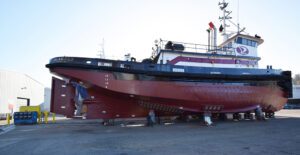
Based in Reedsport, Ore., Fred Wahl Marine Construction has recently made some notable facility improvements.
In 2023, the shipyard purchased a 300-ton travel lift from Ascom, which is now in operation, FWMC Marine Designer Kendall Blake told Pacific Maritime.
The company also recently added supplementary power hookups around the yard to increase vessel storage capacity.
In terms of some notable recently completed projects, the team at Fred Wahl worked on the 100-foot m/v Blarney, a WWII-era towing vessel that traveled up from San Diego for a re-power, Blake explained.
While in the yard for the re-power, the aft fuel tanks were expanded and a small stern sponson was added to the scope of work. The vessel also underwent various updates to meet current load line/stability requirements.
F/V Bay Islander arrived at the shipyard in mid-July 2023 and left in mid-January 2024. The scope of work included replacing the superstructure, pilot house, the installation of a bulbous bow and replacement of a majority of the bulwarks aft to the existing poop deck, along with various other improvements below and above deck.
The remaining interior outfitting was planned to be carried out by ownership.
This spring, the team at Fred Wahl will work on re-power projects for the f/v Progress and f/v Miss Berdie.
Commodore’s Boats
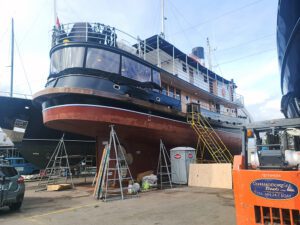
Vancouver-based based boat repair service Commodore’s Boats also has worked on interesting vessels recently, Business Development Manager Ryan Galovich told Pacific Maritime.
Commodore’s Boats flagship wooden boat restoration is an 80-foot, 1912 wooden tugboat, m/v Swell. It was in the yard earlier this year for replacement of deck and foaming around the wheelhouse, Galovich said.
They also conducted annual maintenance, including marine coatings and bottom paint, on a 1904 wooden schooner, Maple Leaf.
Galovich noted that the shipyard also completed several sponsons during the past year, including adding about six feet to the beam of f/v Golden Sun.
“Overall, this was a four-month project that provides the vessel better stability, increased deck space (and) better fuel efficiency,” he said. “We also rebuilt the interior cabin, top house and living area. (It) made for a more comfortable work boat.”
“Lengthening and widening existing boats is our area of expertise,” Galovich said. “These projects maximize boat size to stay within existing fishing licenses.”
Everett Ship Repair
In 2023, Everett Ship Repair completed repairs on Washington State Ferries’ m/v Cathlamet following major damage in 2022.
Everett, Wash.-based Nichols Brothers Boat Builders aided WSF when the Cathlamet collided with the Fauntleroy dock in July 2022. The vessel was towed back to Eagle Harbor in March 2023 to reunite with the WSF fleet.
Everett Ship Repair served as the prime contractor for the emergency repairs and subcontracted NBBB for the pickle fork steel construction. Both companies have long working relationships with WSF.
“Our crews are very familiar with WSF vessels; not only do we repair and build the vessels, we are also routine passengers on the Mukilteo/Clinton route,” Gavin Higgins, CEO of both ESR and NBBB, said in a prepared statement. “The WSF system is very important to each and every one of us and our businesses.”
Cathlamet arrived at ESR in August 2022. The vessel was drydocked, inspected and under-waterline work was done. The vessel was then positioned dockside and work began removing the damaged steel and preparing the vessel for the new steel structure.
After NBBB completed the pickle fork module and it was installed, a new paint system was applied and the systems were tested.
“As an emergency repair job,” ESR Project Manager Kristin Burkhart said, “the m/v Cathlamet project was a unique opportunity for NBBB and ESR to create and execute an agile repair plan that utilized the companies’ capabilities in both new construction and repair.”
Sara Hall has 15 years of experience at several regional and national magazines, online news outlets, and daily and weekly newspapers, where coverage has included reporting on local harbor activities, marine-based news, and regional and state coastal agencies. Her work has included photography, writing, design and layout.

